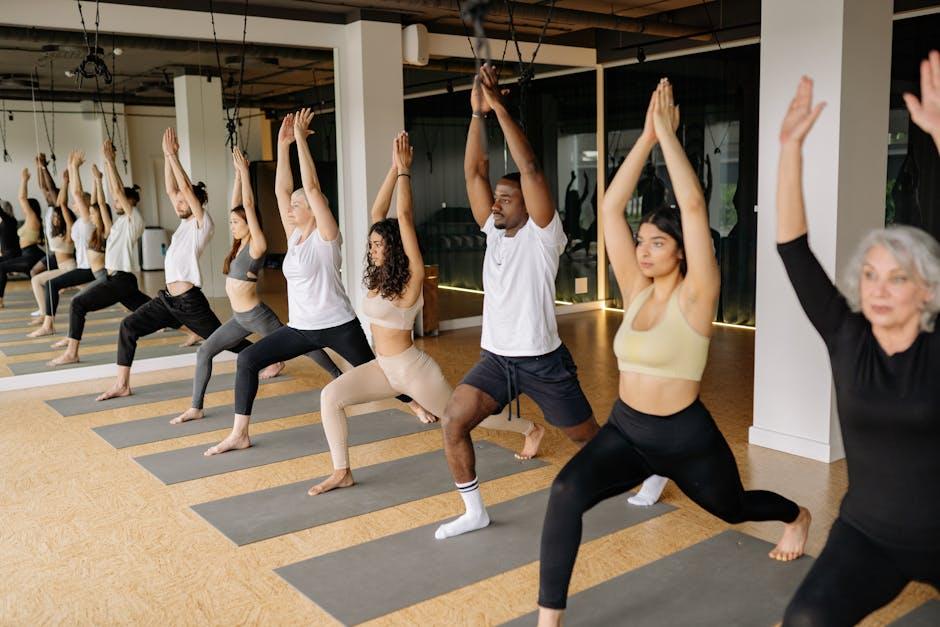In the quest for physical fitness, the world has seen a myriad of trends, each promising transformation and wellness. Yet, amidst the ever-evolving landscape of workout regimens, one ancient practice has not only endured but flourished: yoga. Often depicted as a serene dance of the body and mind, yoga is celebrated for its ability to foster inner peace and flexibility. But beyond the tranquil ambiance and meditative poses lies a pressing question for fitness enthusiasts and skeptics alike: Is yoga an effective workout? As we delve into the heart of this age-old discipline, we seek to unravel the mysteries of its physical benefits, examining whether the mat-bound rituals truly serve as a formidable ally in the pursuit of health and vitality. Join us as we explore the dynamic world of yoga, where the convergence of breath and movement might just redefine your understanding of what it means to work out.
Exploring the Physical Benefits of Yoga
Yoga, a practice that dates back thousands of years, is renowned for its ability to cultivate mental clarity and spiritual well-being. However, the physical advantages it offers are equally compelling. Through a series of postures and movements, yoga enhances flexibility and strength, providing a comprehensive workout for the body. Unlike traditional exercises that often focus on isolated muscle groups, yoga promotes a holistic approach by engaging multiple muscles simultaneously. This not only aids in building core strength but also improves posture and balance.
- Flexibility: Regular practice can lead to increased range of motion and reduced stiffness.
- Muscle Tone: By holding various poses, practitioners can develop lean muscle mass.
- Improved Circulation: The fluid movements in yoga help enhance blood flow throughout the body.
- Joint Health: Gentle stretching and strengthening support joint function and reduce the risk of injury.
Furthermore, yoga is known for its ability to boost cardiovascular health. Dynamic styles like Vinyasa and Ashtanga can elevate the heart rate, providing a mild aerobic workout. As the heart becomes more efficient, overall endurance and energy levels are likely to improve. Yoga also aids in stress reduction, which indirectly benefits physical health by lowering blood pressure and promoting better sleep. Whether you’re a seasoned athlete or a beginner, incorporating yoga into your fitness routine can yield substantial benefits for your body.

Understanding the Mental and Emotional Gains
Engaging in yoga offers profound mental and emotional benefits that extend beyond the physical realm. This ancient practice is a gateway to a more balanced and serene state of mind. The meditative aspect of yoga encourages mindfulness, helping individuals cultivate a deeper connection with their inner selves. Through regular practice, yoga enhances emotional resilience and stability, fostering a sense of peace that permeates daily life.
- Stress Reduction: Yoga’s emphasis on deep breathing and relaxation techniques helps lower cortisol levels, promoting calmness.
- Improved Focus: The concentration required during yoga sessions sharpens mental clarity and enhances cognitive function.
- Emotional Balance: Regular practice aids in emotional regulation, reducing anxiety and depression symptoms.
- Enhanced Self-Awareness: Yoga encourages introspection, leading to a better understanding of personal emotions and triggers.
By weaving together movement and meditation, yoga creates a harmonious environment for mental rejuvenation and emotional healing. This holistic approach not only fortifies the body but also nurtures the soul, providing a sanctuary from the stressors of modern life.

Comparing Yoga to Traditional Workouts
When it comes to fitness, the options are as varied as the goals people set for themselves. Traditional workouts, such as weightlifting, running, or high-intensity interval training (HIIT), are often favored for their direct approach to building strength and endurance. These exercises typically focus on increasing muscle mass, improving cardiovascular health, and burning calories. They offer a straightforward path to measurable results, which can be highly motivating for those seeking quick progress. On the other hand, yoga offers a more holistic approach to physical fitness, emphasizing the union of mind, body, and spirit.
- Flexibility and Balance: While traditional workouts excel in building strength, yoga stands out for enhancing flexibility and balance, crucial for preventing injuries and improving overall mobility.
- Mental Well-being: Unlike many traditional workouts, yoga incorporates mindfulness and meditation, providing mental health benefits that are just as important as physical ones.
- Customization: Yoga offers a wide variety of styles and intensities, from the gentle flow of Hatha to the vigorous pace of Ashtanga, making it accessible to all fitness levels.
Ultimately, the choice between yoga and traditional workouts depends on personal fitness goals and preferences. Each offers unique benefits, and integrating both into a fitness routine can provide a balanced approach to health and wellness.

Tips for Integrating Yoga into Your Fitness Routine
Incorporating yoga into your fitness regimen can be a seamless and rewarding experience. Here are some creative strategies to ensure a harmonious blend:
- Start with Complementary Poses: Choose yoga poses that complement your existing workouts. For instance, if you’re a runner, incorporate hip openers and hamstring stretches to improve flexibility and prevent injuries.
- Time Your Sessions Wisely: Consider practicing yoga on rest days or as a cool-down after intense workouts. This not only aids in muscle recovery but also enhances mental relaxation.
- Set Clear Intentions: Define what you aim to achieve with yoga—be it improved flexibility, better balance, or mental clarity. This focus will guide your practice and integrate it meaningfully into your routine.
- Explore Different Styles: Experiment with various yoga styles like Vinyasa for cardio, Yin for deep stretching, or Power Yoga for strength building. This diversity keeps your routine fresh and engaging.
Embracing yoga as a part of your fitness routine doesn’t require a complete overhaul of your existing schedule. Instead, it invites a holistic approach to wellness that balances physical exertion with mindful relaxation.































